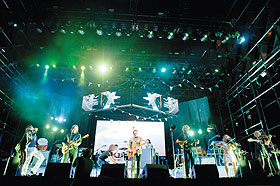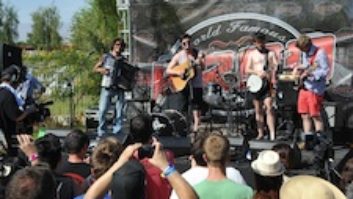
Arcade Fire—no stranger to Coachella. This is the band’s third appearance at the festival.
All performance photos and engineer shot are credited to Dave Vann.
If you couldn’t jet down to Southern California for the annual Coachella festival, sitting in front of your computer may have been the next-best thing. During the three-day event, nearly 4 million views were recorded on the YouTube Coachella streaming page, which hosted three separate channels.
Post-event, the numbers are just as staggering: Just a week after the show wrapped, Mumford & Sons had 134,000 views, Whiz Kaleefa 75,000. The day The National videos were posted, it had, only after a few hours, 14,000 views. Long engagement times, speared on by high-quality audio and video.
Handling the audio and video streaming production was Hank Neuberger and his Springboard Productions. This is his fifth year working with Coachella promoter Golden Voice; he’s been working festivals since 2006, beginning with Lollapalooza. At this year’s Coachella (April 15-17, 2011), he led a crew of 100, which included Guy Charbonneau of Le Mobile and Chris Shepard of American Mobile.
“We’re shooting on four of the stages, almost every performance on the four main stages,” Neuberger says. “We also have multitrack audio recording for all four stages. Then we have a central video world where we have our directors working for each stage. Then our master control room, where we are producing nine hours of live content from the festival, every day, times three channels. This is the second year we’ve done that [three channels], but not every festival has done that. We did more than 60 bands, including the headliners—Kings of Leon, Arcade Fire, Kanye West and other major groups like the Black Keys and The Strokes—those were all live live.”

Cee-Lo Green and backing band performing for an exuberant crowd at Coachella 2011

The members of Interpol played the first night of the show.
During the festival, there were always two bands playing on separate stages, sometimes all three stages going at once. On the YouTube site, fans could choose which band to view or sample, as well as listen to artist interviews. For those segments, Neuberger had three ENG crews working onsite doing interviews that were immediately edited and put into the Webcast. Some notable interview subjects included Paul McCartney, Arcade Fire, Lauryn Hill, Usher and many more.
THE AUDIO COMPONENT
In festivals, especially at Coachella where there are eight, nine or sometimes 10 bands playing on a single stage in one day, it moves pretty quickly. Fortunately, Neuberger had a stellar crew to help deliver audio. At the first stage was Charbonneau in his Le Mobile truck with its Neve 8060. On the second stage was Shepard engineering in his American Mobile truck, which hosts a Pro Tools system. At the third stage was a Flypack from Le Mobile, engineered by Guy Charbonneau’s son, Ian Charbonneau (who is also a veteran of the Coachella mixes). Finally, at the fourth stage was a Flypack from American Mobile with Steve Weeder engineering.
“Since [the festival] moves quickly, I need people who are festival veterans and great mixers, and I’ve been fortunate to have them here at Coachella,” Neuberger enthuses.
But before a single stream is created, Neuberger is acutely aware that there can be a misconception that audio will lag behind video, there will be dropouts, etc. To ensure he’s sending out the highest-quality stream (in the case of Coachella, it was at 24/48), their testing starts the day before the festival. “We do a clap test to dial in audio and video sync on each stage before we go on the air, and we check it every day,” he explains. “We consider that one of our key tests: from stage to Master Control [Neuberger’s domain, where all of the stages are being recorded], all the way through our tech services partner and encoding partner to YouTube. And typically on a festival, I’ll do a fax-through with a full satellite uplink to the platform partner on the afternoon before the festival starts. I’ll have an A2 onstage doing a clap test that my directors are looking at on camera so we can listen to it and guarantee the sync all the way through to our platform partner at the end of the line.”

The Coachella YouTube stream allowed fans to choose from three different channels.
With all systems go the day of show, the real test comes once the band takes the stage. “We always get as a safety the front-of-house [mix] and we make sure we grab that at their feed to the drive lines so that no band can accidentally interrupt it,” Neuberger explains. “Rarely but occasionally for a headliner’s mix, they have a reference they’d like for us to use because they have a lot of audio production in their set. So on occasion, we’ll use the front-of-house mix and add audience, but 90 percent of the shows we’re capturing the multitrack audio and our mixers are creating a custom mix with audience for the broadcast. Everybody’s mixing on the fly. We get a good mix quickly; we might get a line check if we’re lucky, and then the band walks out and they start to play.”

Lauryn Hill’s involvement included a live performance and exclusive interview.

Conor Oberst of Bright Eyes
Taking a hybrid approach to the mix—part broadcast mixing, part live sound mixing—Neuberger’s main focus as soon as the band hits the first note is how quickly the engineers can get an excellent balance dialed in, especially with bands those engineers are not intimately familiar with.
As soon as the mix is up and running, the feed is sent to Master Control. All performances are recorded with the video line cut in the live mix and EVS in the Trio Video trucks. “We recorded on their Elvis, which is the nickname for the EVS. We are extensively using EVS in this truck and this production, but my Webcast director then calls up the band I’ve scheduled and either puts it on the line for one of those channels: live live or if it’s been slightly time-shifted, he can call it up. Audio is already married to the line cut at that time; there’s no sweetening at that point.”
SENDING TO THE WORLD
The next link in the chain is tech services partner AEG-Digital Media, which Neuberger says did an incredible job of encoding. AEG-Digital Media’s video player was embedded in the YouTube channel and easily supported the three-channel experience.
“And then the final link is this year, for the first year, we were able to have a platform partner of YouTube,” Neuberger says. “YouTube is the expert in full-motion video; that’s where people come for full-motion video. They were great partners and they were right there in my truck all weekend so we could work interactively as things changed, schedules needed to be modified; they were a great partner.”
Also important is the technology advances both companies have contributed to this emerging trend. While Neuberger may be sending out high-res audio, some viewers may be hearing it in less-than-ideal situations. Fortunately, YouTube and AEG-Digital Media have solutions to ensure that each stream is heard in its most pristine shape. “These things are all doing a dynamic adaptive screening and they’re able now to diagnostically check the end-user’s broadband, pipeline speed and speed of their computer processor. The video player dynamically adapts to what the end-user can accommodate. So if you’ve got a great broadband piped into your house and a top-tier computer, you’re going to get the highest quality. If you’re on a dial-up with a 9-year-old laptop, it automatically throttles down. Unlike a year or two ago, the end-user doesn’t have to do anything.
“The technology has changed and I think finally, with Coachella 2011, we have been able to deliver a rich, musically rewarding experience that we could all envision in 2006, but the signal path wasn’t there,” he continues. “It’s been improving. We received this year a number of compliments about the audio quality. So we know the audio and video was received by the end-user in a high-quality fashion. The number of viewers plus the engagement time tells me that people found it rewarding, and I think we’ve finally crossed a major bridge in being able to deliver a technically satisfying experience.
“I’ve been increasingly pleased with the quality and fidelity that comes out online when I’m working with such top-tiered encoding partners and platform partners. I’ve been really pleased with the final audio. I specifically sat in the truck when Guy was mixing Kings of Leon and it sounded great. We’ve finally got ourselves into a space with strategic partners. My Springboard Productions company, which has done more than 20 festivals, we understand how to make this work in a festival context, which moves so quickly. There’s no soundcheck; there’s barely a line check. For video and audio, this is moving incredibly quickly.”


VIEW FROM FOH: SNAKE NEWTON MIXES DURAN DURAN
While Neuberger and crew were busy creating the audio and video mixes for the stream, those fans at the show were treated to a great-sounding set from Duran Duran, courtesy front-of-house engineer Snake Newton.
Eighth Day Sound supplied the Avid Profile for the festival. Newton had five DSP HDXs with his HD3 system; outboard gear included two TC Electronic dB Max units—one of the mix and one on the lead vocal. Newton mostly relied on onboard effects, including Waves Live, and plug-ins from Sonnox, Crane Song and TC Electronic.
While Snake didn’t have an opportunity to soundcheck with the band, he was already familiar with the festival’s L-Acoustics K1 system. “I’ve had many months of experience mixing on it, mostly in arenas but some outdoor [events],” he says. “It is my favorite large-scale system. The K1 is very ‘true,’ so I wasn’t worried in the slightest [about not having soundcheck].”
Newton miked vocalists with a Shure Beta 58, while a smattering of Sennheiser, AKG and Audio-Technica models dotted the rest of the instruments onstage. “I like to choose the mic for the job and not be limited by an endorsement,” Newton says.
When asked if he has a different mixing style for the band when they hit the festival stage as opposed to their arena run, he replies, “Duran Duran’s sound varies so much from song to song and era to era that everything is programmed to change from song to song. I have over 60 songs programmed into the console. The only things untouched by the automation is the kick and bass guitar and the lead vocal; everything else is in the snapshot. It doesn’t really change in a festival situation.
“Coachella was fun for me,” he continues. “It was an important gig for the band as they wanted to prove that they are a force still to be reckoned with musically. Their new album [All You Need Is Now] stands up really well, even in this day and age. Both band and crew really enjoyed the experience.”
VIEW FROM FOH: BRENT RAWLINGS MIXES KINGS OF LEON
Rawlings manned a Midas XL8 board during Coachella, saying that he keeps the board as analog as possible. “Only my effects and mutes are automated, and the occasional pan. All the effects are in the console, hence the automation of delay and reverb times.”
Rawlings was able to do a line check and soundcheck at the festival, and his previous knowledge of the L-Acoustics K1 array helped in those hurried times. “My style of mixing the Kings is simple,” he says. “It’s a rock band: Everything even with the vocal top. I crank the solos. The festival is kind of a freebie because there’s no walls or ceilings to reflect the sound, which makes my job a little easier.”


